When exploring the great outdoors, the choice of your ride can make all the difference. With the Honda Pioneer and the Polaris Ranger in the picture, you’re faced with two of the most prominent players in the UTV market. Each comes with its own set of features tailored to enhance your off-roading adventures. If you’re in the market for a utility vehicle that balances power, reliability, and functionality, diving into the specifics of these two models can help guide your decision.
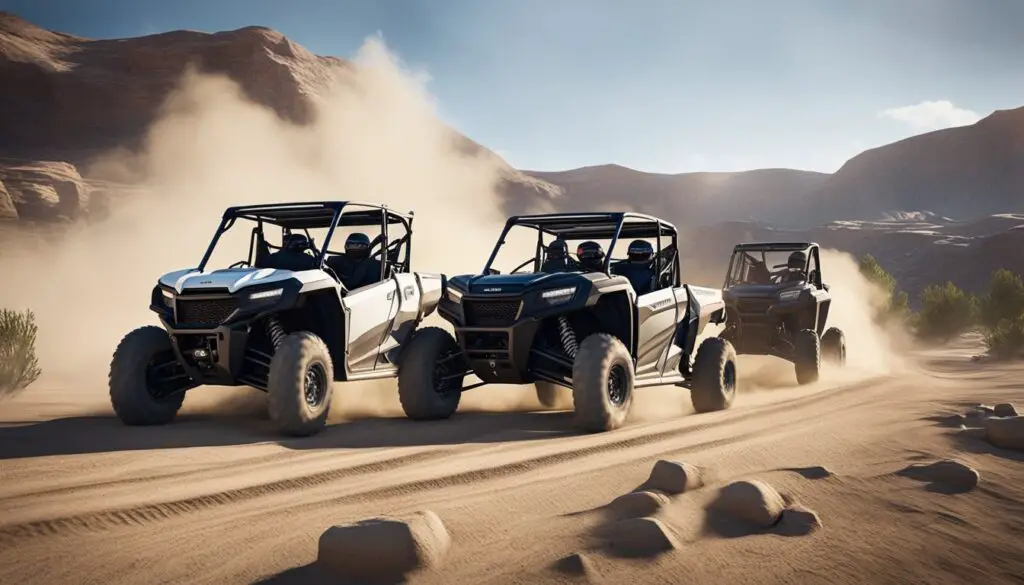
The Polaris Ranger is revered for its powerful 80 horsepower engine that ensures a smooth and robust ride across various terrains. Its efficient Continuously Variable Transmission (CVT) system is designed to deliver power to the wheels effectively, making it a top choice for those requiring a hardworking vehicle. On the other hand, the Honda Pioneer is not far off with a 72 horsepower output and the added benefit of a Dual Clutch Transmission, which promises quick shifts and a smooth performance.
Comparing payload capacities and price brackets, the Polaris Ranger often offers a higher payload, which is great if you need to lug around more gear or supplies. Price-wise, both UTVs are in a similar range, giving you the flexibility to choose based on your priority—be it price, power, or payload. Exploring each model’s capacity, features, and handling can lead you to the UTV that best fits your outdoor lifestyle.
Brand Overview
When you’re choosing between the Honda Pioneer and the Polaris Ranger, you’re looking at two leaders in the UTV market. Each brings a unique history and strengths that cater to various off-road needs.
Honda UTV History
Honda entered the UTV scene with a reputation for reliability. Their Pioneer line-up is a testament to their engineering tradition, offering a range of models tailored for both work and recreation. The Pioneer 500, known for its fuel efficiency and compact size, was a game-changer for those needing a smaller, yet capable, UTV. The larger Pioneer 1000 is recognized for its powerful 72 hp engine and innovative Dual Clutch Transmission (DCT).
Polaris UTV History
Polaris is synonymous with off-road innovation, and the Ranger series stands out as a hallmark in their lineup. Starting out, Polaris set the pace with their 500cc UTVs that blended capability with performance. The Ranger 1000, one of their most popular models, sports an 80 hp engine and boasts Polaris’ proprietary PVT transmission, optimizing power distribution and efficiency. Their focus on constant evolution keeps them at the forefront of the UTV market.
Honda Pioneer vs Polaris Ranger Comparison
In this section, you’ll get a detailed comparison of the Honda Pioneer and Polaris Ranger models, specifically focusing on their engine performance, price points, and key features for each model range.
Honda Pioneer
The Honda Pioneer lineup offers a range of models starting with the Pioneer 500 equipped with a 500cc engine. This model is known for Honda’s legendary reliability which often translates into a higher resale value. Moving up, the Pioneer 700 offers a solid balance between power and functionality, suitable for a variety of tasks. The top-tier Pioneer 1000 elevates the experience further with a powerful 72 hp engine and a Dual Clutch Transmission providing a smooth and responsive ride.
- Honda Pioneer Pros:
- DCT provides a smooth transmission experience.
- Reliable performance consistent with Honda’s reputation.
Polaris Ranger
On the other hand, the Polaris Ranger series starts with the Ranger 570, progressing to the middle of the range Ranger 700, and up to the Ranger 1000 models. The Ranger 1000 is particularly noteworthy for its 80 hp engine output, which is higher than its Honda counterpart. Polaris Ranger’s design is robust, and higher-end models like the Northstar Edition and Trail Boss deliver exceptional features, including climate control and advanced suspension systems, respectively.
- Polaris Ranger Pros:
- CVT achieves efficient power delivery to the wheels.
- High-clearance chassis suited for tough conditions.
Side-By-Side Comparison
When evaluating both vehicles side by side, you’ll notice that price points for entry models are comparable, with the Honda Pioneer ranging from ,599 to ,699 and Polaris Ranger from $9,299 to $17,799. Each brand brings their own strengths to the table, with the Ranger tending to offer a little more power and the Pioneer focusing on reliability and transmission quality. Here’s a quick spec comparison to help you see the differences more clearly:
| Specification | Honda Pioneer 1000 | Polaris Ranger 1000 |
|---|---|---|
| Engine Output (hp) | 72 | 80 |
| Transmission Type | Dual Clutch Transmission | CVT |
| MSRP Range | $8,599 – $13,699 | $9,299 – $17,799 |
| Notable Features | Higher resale value | More power, Northstar Edition & Trail Boss features |
Design and Comfort
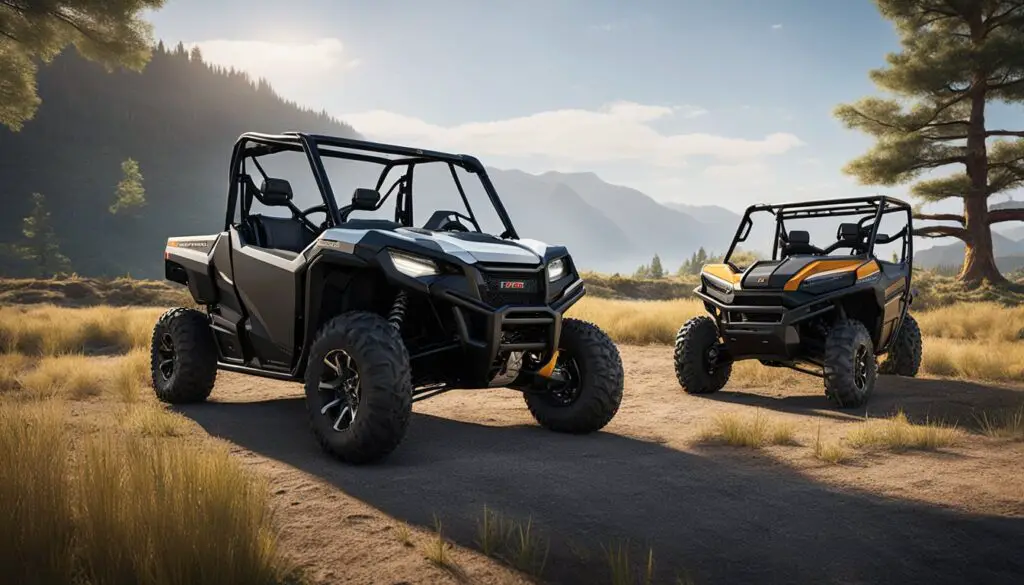
When choosing between the Honda Pioneer and the Polaris Ranger, you’ll find that both offer unique design features and comfort levels tailored to enhance your off-road experience.
Pioneer Design Features
The Honda Pioneer is built with practicality in mind. You’ll appreciate the thoughtful storage solutions, including a glove box and multiple compartments within the cab area that allow you to keep your essentials secure and organized. The Pioneer’s cab design aims to provide a safe and enclosed feel, perfect for those unpredictable journeys through different terrains.
- Storage: Glove box, under-seat compartments
- Cab: Enclosed design
- Seat: Contoured for support
Ranger Design Features
In contrast, the Polaris Ranger boasts its own set of design enhancements. A standout feature is its available heat options within the crew trim, ensuring you stay warm during colder adventures. The Ranger also offers an adjustable seat slider for the driver’s seat, allowing you to find the perfect driving position with ease.
- Storage: Extended box capacity
- Cab: Options for enclosed feeling and heating
- Seat: Adjustable seat slider for driver comfort
Seating and Space
When it comes to seating and space , the Honda Pioneer provides a comfortable ride with well-contoured seats that cater to longer journeys. Meanwhile, the Polaris Ranger, especially in the crew trim, offers ample space for passengers. Both models are designed with your comfort in mind, whether you’re tackling tough jobs or exploring trails.
Engine and Performance

Exploring the differences in engine and performance between the Honda Pioneer and Polaris Ranger, you’ll find that each offers unique specifications and capabilities. Here’s a closer look at what each provides under the hood.
Engine Specs
Honda Pioneer: Honda’s Pioneer series typically boasts engines ranging from a 500cc to a 999cc liquid-cooled, 4-stroke, twin-cylinder DOHC engine depending on the model.
Polaris Ranger: Polaris offers engines like the 570cc ProStar engine up to the 1000cc ProStar engine. The Ranger 1000, for example, delivers around 80 horsepower, which is more than the typical Honda Pioneer’s around 72 horsepower.
Drivetrain and Transmission
Honda Pioneer:
- Drivetrain: The Pioneer utilizes a shaft-driven driveline.
- Transmission: Depending on the model, you can expect a dual-clutch transmission, which provides smooth gear changes and reliable performance.
Polaris Ranger:
- Drivetrain: Polaris opts for a High-Performance On-Demand True AWD/2WD drivetrain.
- Transmission: They usually equip the Ranger with an Automatic PVT (Polaris Variable Transmission), which includes a drive belt system for efficient power delivery.
Handling and Control
When it comes to handling and control, both the Honda Pioneer and Polaris Ranger provide user-friendly experiences with subtle differences:
- Suspension: Both vehicles sport high-performance suspension systems, yet the specific setups may vary, contributing to the overall ride quality and control.
- Steering: Typically equipped with rack and pinion steering, they offer precision and ease when navigating.
- Tires and Wheelbase: The choice of tires and the differing wheelbases between models affect turning radius and acceleration.
Utility and Functionality
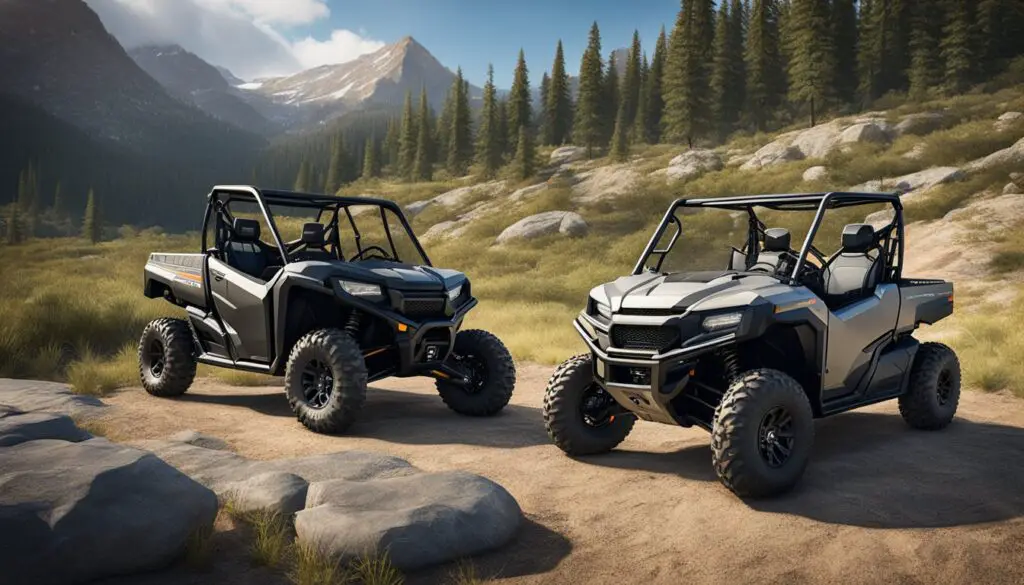
When comparing the Honda Pioneer and Polaris Ranger, you’ll find both side-by-sides excel in different aspects of utility and functionality. Understanding their towing and payload capabilities, fuel specifications, and storage options will help identify the right choice for your specific needs.
Towing and Payload
Honda Pioneer:
- Towing capacity: Capable of towing up to 2,000 pounds.
- Payload capacity: Accommodates up to 1,000 pounds of payload, depending on the model.
Polaris Ranger:
- Towing capacity: Offers a towing capacity that can reach up to 2,500 pounds in certain models.
- Payload capacity: Handles a payload capacity that can be as high as 1,500 pounds for particular models.
Fuel Economy and Tank Specs
Both vehicles typically feature Electronic Fuel Injection (EFI), which enhances fuel consumption efficiency.
Honda Pioneer:
- Fuel tank capacity: Usually offers a fuel tank size around 7.9 gallons.
- Fuel economy: Generally efficient but specific figures depend on the model and conditions of use.
Polaris Ranger:
- Fuel tank capacity: Comes with a larger fuel tank, with capacities reaching up to 10 gallons in some models.
- Fuel economy: Comparable to the Pioneer, though the larger tank may provide longer range between fill-ups under similar conditions.
Storage and Carrying Capacity
Honda Pioneer:
- Storage solutions include a glove box and under-seat storage compartments. The cargo box design varies but is optimized for functionality.
Polaris Ranger:
- Equipped with a versatile cargo box at the back and additional storage compartments inside the vehicle. The Ranger line often includes more expansive storage options.
Be sure to assess the specific configurations of each vehicle, as capacities and features can vary by model.
Terrain and Off-Road Capabilities
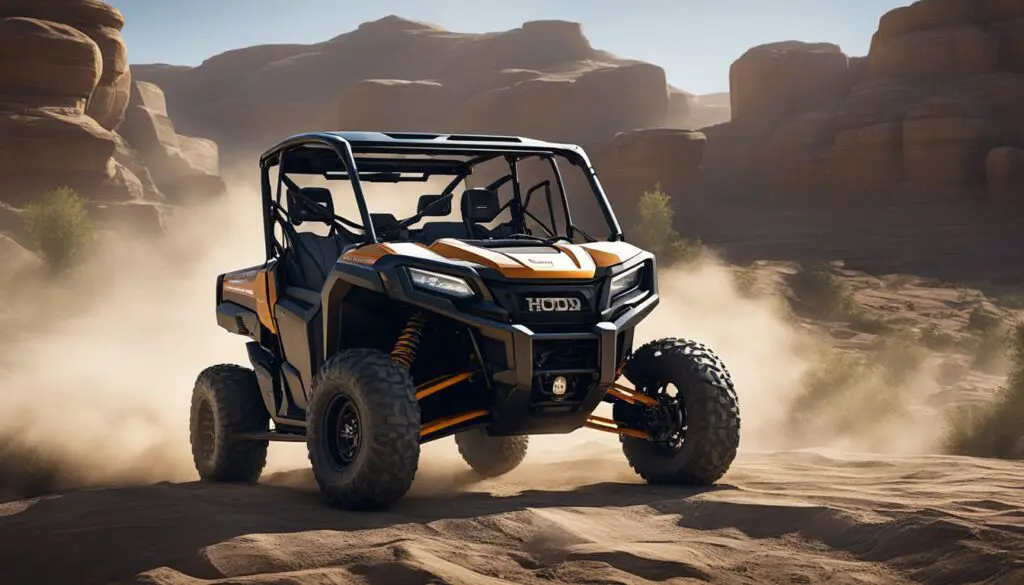
When you’re deciding between the Honda Pioneer and the Polaris Ranger, your off-road experience hinges on how well each vehicle can handle rough terrain. Your adventure might take you over rocks and through mud, so let’s explore how these vehicles stand up to challenging landscapes.
Ground Clearance and Suspension
Honda Pioneer:
- Ground Clearance: It’s crucial for navigating over obstacles without scraping the bottom of the vehicle. The Honda Pioneer generally offers respectable clearance, although specific figures can vary based on the model.
- Suspension: The suspension system on the Pioneer is designed for a smooth ride, which diminishes the roughness you feel when traversing rocky paths or uneven ground.
Polaris Ranger:
- Ground Clearance: The Ranger typically features a high-clearance chassis which is ideal for serious off-roading and avoiding contact with ground obstructions.
- Suspension: Equipped with an advanced suspension system, the Ranger provides significant shock absorption, allowing for greater ride comfort and control when the trail gets tough.
Tires and Drivability
Tires:
- Both the Honda Pioneer and Polaris Ranger come with tires designed for off-road use; meaning they have deep treads for improved traction on slippery surfaces.
Drivability:
- The Honda Pioneer boasts a turning radius that’s conducive to tight trails, making it easier for you to maneuver through dense woods or tricky bends.
- Contrarily, the Polaris Ranger features a drivetrain that efficiently transfers power to the wheels, enhancing your ability to tackle steep inclines or mucky conditions with confidence.
Safety and Durability
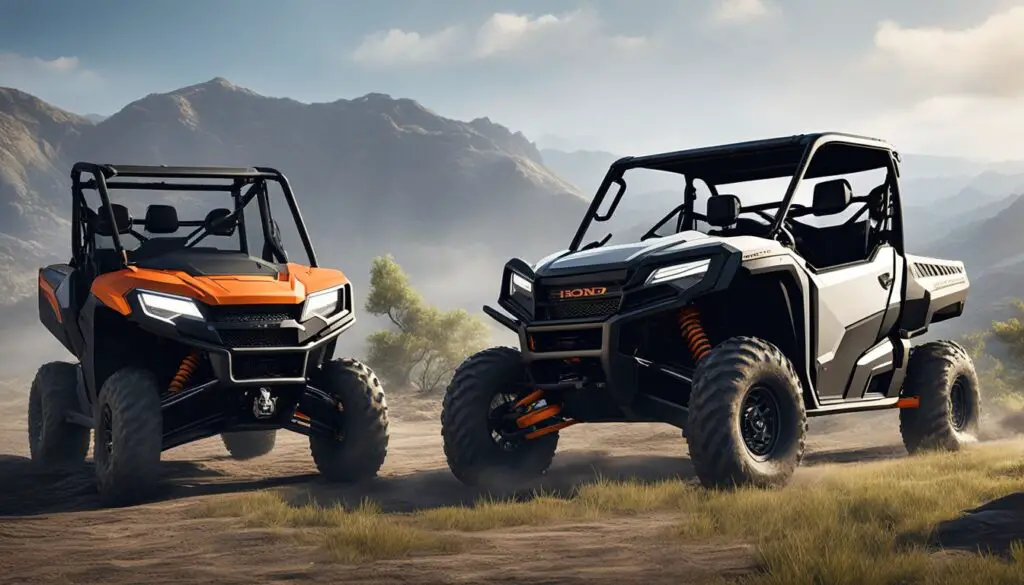
When you’re in the market for a utility terrain vehicle (UTV), safety and durability are paramount. Both the Honda Pioneer and the Polaris Ranger have invested heavily in these aspects, ensuring you get a blend of reliability and control.
Roll Cage and Chassis
The roll cage is your first line of defense in the event of a rollover. Both vehicles come with robust roll cages that meet or exceed industry safety standards, designed to protect you during unexpected incidents.
- Honda Pioneer: Features a sturdy construction that upholds Honda’s dedication to safety.
- Polaris Ranger: Offers a high-clearance chassis and a strong roll cage, giving you confidence in its structural integrity.
Brakes and Safety Features
Brakes are critical for maintaining control and safety, especially in rough terrain.
- Honda Pioneer:
- Brakes: Equipped with a responsive braking system to stop reliably.
- Safety Features: Traditional Honda reliability extends to its safety features, providing consistent performance.
- Polaris Ranger:
- Brakes: Includes well-engineered brakes designed for precise control.
- Safety Features: Alongside its durable design, it offers additional safety features that complement the braking system.
Pricing and Value
When considering the Honda Pioneer and Polaris Ranger, your budget will play a significant role. Let’s break down the cost and the value you get for your money.
Pioneer Pricing
The Honda Pioneer has a starting MSRP ranging from $8,599 to $13,699. It’s essential to note that the higher end of the price spectrum reflects models with advanced features and capabilities.
Ranger Pricing
In contrast, the Polaris Ranger offers a broader price range, starting at $9,299 and climbing to $17,799. The varying price points correspond to different models, with the upper range featuring more powerful engines and premium features.
Cost-Benefit Analysis
Considering the Honda Pioneer, you pay for the brand’s known reliability, while Polaris Ranger brings you more power for a higher initial investment. Examining the pros and cons is crucial:
- Honda Pioneer Pros:
- Renowned reliability
- Efficient power delivery
- Polaris Ranger Pros:
- Higher horsepower
- Advanced CVT efficiency
Resale Value
Honda’s legendary reliability can contribute to a greater resale value. On the other hand, a well-maintained Polaris Ranger, with its robust chassis and high-clearance, may also hold a good portion of its value over time. It’s important to maintain your vehicle properly to maximize resale potential.
Customization and Accessories
When you’re aiming to enhance your side-by-side experience, both the Honda Pioneer and Polaris Ranger offer a diverse range of upgrades and accessories. Your choice of customizability options directly impacts features, storage, and performance, ensuring your vehicle fits your specific needs.
Available Upgrades
The Polaris Ranger and Honda Pioneer come with a variety of available upgrades catering to design and performance enhancements. These upgrades allow you to tailor the vehicles to your liking, whether that’s for work or recreation.
- Polaris Ranger:
- Engine – Upgrade options for more powerful engines are available for those seeking extra performance.
- Suspension – Enhanced shock absorbers and lift kits can be added for better off-road handling and comfort.
- Honda Pioneer:
- Tires and Wheels – Choices range from all-terrain to mud-ready, allowing you to conquer diverse landscapes.
- Protection – You can opt for upgraded skid plates and brush guards to protect against the harshest conditions.
Accessory Options
The range of accessory options for the Polaris Ranger and Honda Pioneer extends to features that augment cargo capacity and utility.
- Polaris Ranger:
- Storage: The Ranger’s accessory lineup includes under-seat storage solutions and cargo bed extenders to maximize carrying capacity.
- Customizability: Polaris offers a myriad of options such as custom seats and LED light packages for both utility and aesthetic enhancement.
- Honda Pioneer:
- Cargo: Genuine Honda accessories like cargo boxes and bed extenders add versatility to your storage options.
- Features: Additional features such as heated cab components and audio systems help to personalize and upgrade your Pioneer experience.
Frequently Asked Questions
In this section, you’ll find targeted information to clarify common queries about the Honda Pioneer and Polaris Ranger, from specifications to value for money and maintenance.
What are the key differences in specifications between the Honda Pioneer and the Polaris Ranger?
The Honda Pioneer offers a Dual Clutch Transmission and typically has a horsepower of 72 HP. On the other hand, the Polaris Ranger uses a Continuously Variable Transmission (CVT) and has power output specs like 80 hp for the Ranger 1000, reflecting an 11% increase over the Pioneer’s horsepower.
What experiences have users shared about Honda Pioneer and Polaris Ranger on forums and Reddit?
Users often cite the Polaris Ranger’s CVT efficiency and overall power, as well as a robust chassis suitable for rugged conditions. The Honda Pioneer is frequently commended for its reliability and Dual Clutch Transmission’s performance.
How do the prices compare between the Honda Pioneer and the Polaris Ranger?
The starting prices for the Honda Pioneer range from $8,599 to $13,699, whereas the Polaris Ranger models start from $9,299 and can go up to $17,799, with variations depending on specific models and features.
Which model offers better value for money, the Honda Pioneer, the Polaris Ranger, or the Can-Am Defender?
Value for money is subjective based on your priorities, but the Honda Pioneer is known for reliability, the Polaris Ranger for its performance, and the Can-Am Defender offers versatility. Comparing specifications relative to price can help determine the best option for your needs.
How do the Honda Pioneer and Polaris Ranger compare in terms of towing and payload capacity?
Payload and towing capacities vary by model, but the Polaris Rangers are typically known for having a larger payload capacity compared to the Honda Pioneers. Exact numbers should be checked according to specific model variants.
What are some common maintenance concerns for the Honda Pioneer and the Polaris Ranger?
General maintenance concerns for these vehicles include regular oil changes, belt inspections for the Polaris Ranger’s CVT, and attention to the Dual Clutch Transmission system in the Honda Pioneer. The frequency and nature of these maintenance tasks can be model-specific.

Leave a Reply